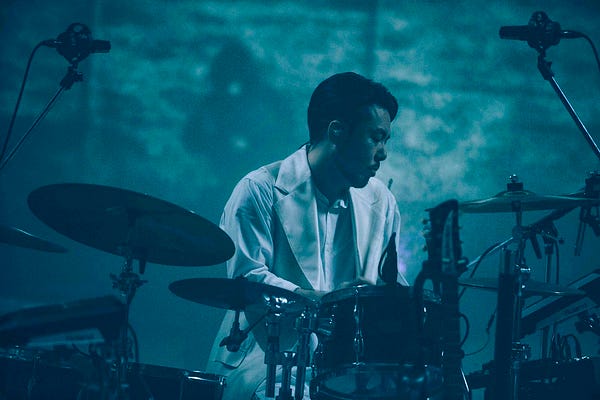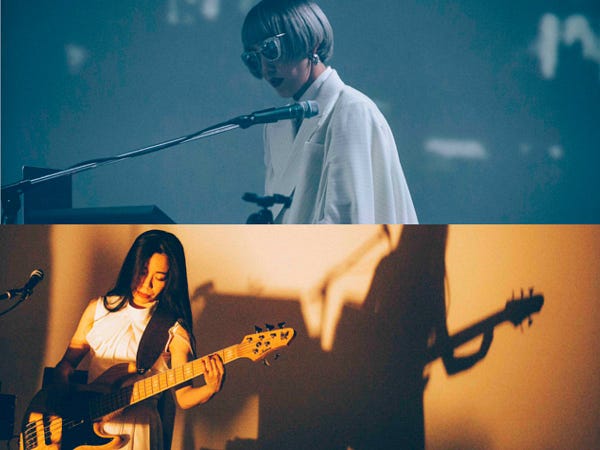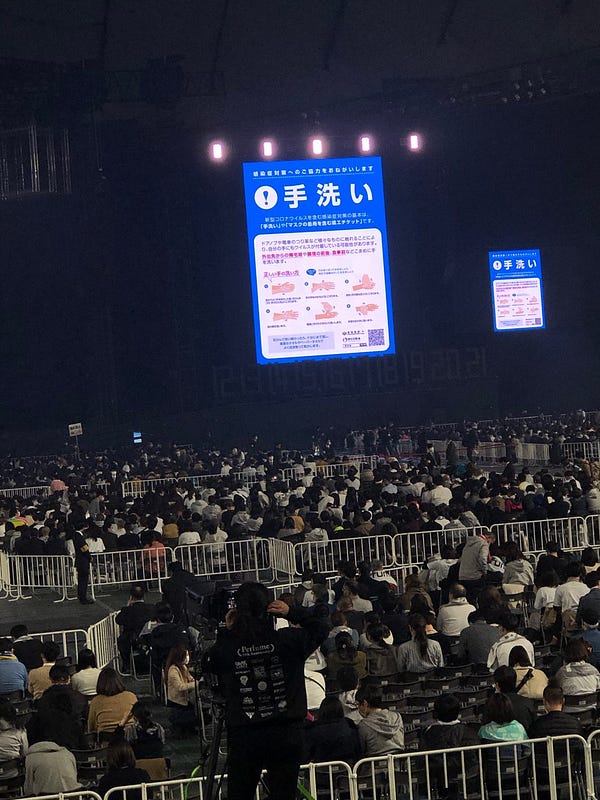Make Believe Mailer 02: New Angles On The New Normal
How Sakanaction turned the online livestream concert into something more

Sakanaction, courtesy of PR Times
I can still remember my personal “uh oh” moment regarding COVID-19. I was sitting inside the Tokyo Dome in late February, waiting for Perfume to play the first of two shows at the venue. While concerns over the novel coronavirus were on the rise — this was peak panic time regarding the Diamond Princess cruise ship in nearby Yokohama, and all the potentially sick passengers released too early — that didn’t stop thousands upon thousands of fans from filling Tokyo Dome. Staff had put out extra hand sanitizer stations in the concourse and before the performance started, the on-screen entertainment was...a how-to-wash-hands guide.
Sometime during the pre-show, reports started spreading on Twitter that a person found to have had COVID-19 had attended a large-scale concert in the Kyushu region. Online speculation narrowed the event down to either a show put on by pop-punk band WANIMA...or one by Perfume. It became clear shortly after it was the prior, but this development made crowding into a domed baseball stadium with around 50,000 feel a whole lot less optimal, even if they put out extra hand soap. It ironically would also become one of the last happy memories of live music, because the next day nearly every major concert in Japan postponed or cancelled at the government’s recommendation.
Half a year on, one of the first industries in Japan to close due to COVID-19 still largely remains inactive. Every major nationwide tour sits grounded, and the summer festival slate was wiped clean, with the postponement of this September’s Supersonic being the last gathering to be pushed back. “I was eager to see Supersonic kick off the revival of the live music industry...but honestly, it was too early to challenge this,” concert organizer Creativeman CEO Naoki Shimizu told me in email the day after the announcement.
He remains upbeat about the possibility of bigger live music in 2021 — ”if we learn from this year” — but that leaves the rest of 2020 in an odd position. While gatherings of 5000 people have been allowed (resulting in shows such as this one in Osaka, where large numbers of fans gathered together indoors), recent nationwide spikes in cases guarantee that capacity number won’t go up anytime soon. So considering how much money is also being lost because of this — Nikkei reported in May that the closure of all live events resulted in losses of ¥28 billion in the Kansai region alone — musicians and companies need to figure out some sort of stopgap.
One event from last weekend might show a possible way forward...at least for the next few months. Rock band Sakanaction’s Sakanaquarium Hikari, held over August 15 and 16, aimed to turn the livestream concert into an elevated experience. For top-level acts, it might be a blueprint to turning a format that has become predictable into something more interesting.
Livestream events popped up early during the outbreak times, pushed forward by e-ticketing platforms such as Zaiko, who put on the first notable online concert (by the band cero) and a whole dance festival. Soon enough, these type of digital happenings morphed into standard fare, both in free versions on YouTube and ticketed offerings, which sprung up rapidly as major companies realized how the year was going to go (and...speculation...saw how well it worked for early adapters and rigged up their own). The past spring was all about forced changed for the Japanese music industry — subscription streaming became vital, concert footage once found only on pricey DVD landed on YouTube to entertain a nation staying at home, and concerts playing out on the web started becoming the norm.
Unlike similar state-of-emergency offerings aimed at a captive audience — YouTube dinner sessions and idols playing video games — the livestream concert experience only gained steam as the months went on, cases dipped and the government rushed to open up familiar aspects of life in cities. Yet the experience also became formulaic, often tipping over to the bland. It looked and sounded like a show from pre-COVID times, but with no attendees and little atmosphere. Tatsuro Yamashita might have been a step ahead of other acts when he charged for an online viewing of a concert from just a few years ago — that might be old footage, but it also had the actual crowd reactions of a show, a nostalgic element in 2020.
Enter Sakanaquarium Hikari. Sakanaction initially joined the wave of Japanese artist uploading concerts to YouTube shortly after they had to postpone a nationwide tour in February, but for the summer they decided to put on their first online live ever. Rather than settle for the by-then familiar, they opted to turn it into something more. They worked with German company Klang Technologies to introduce 3D sound technologies, and they approached the stream as a chance to turn each song into its own little experience. While these ideas have been implemented in Japanese concerts before, they haven’t appeared in any COVID-era online broadcasts, which tend to go for simplicity.





Sakanaquarium Hikari proved a success, bringing in what appears to be a large number of paying customers (going off of social media) and a genuinely novel approach to the stuck-at-home experience (going off of social media...I missed this live, but the bits I’ve seen online deliver). Music journalist Shiba Tomonori’s reaction overflowed with praise, impressed both by Sakanaction’s aim to see what was possible with online technology and their ability to still hit on familiar elements of an IRL concert (say, like sweating a bunch, a tiny detail but something you don’t see in much of the relaxed livestreams out there). They even had special merch, including some very suave looking slippers modeled after the album art of their 2019 album.
It’s of course something not all bands can manage — Sakanaction are one of the biggest acts in Japan, and have the capital to try something like this, which is a reality many other performers even on major labels can only daydream about while spending another night in their living room. For the top-level artists, though, who rely a lot on tours and biggie-sized shows, Sakanaquarium Hikari should serve as an inspiration moving forward. If this really is the “new normal,” as a recent press release from Zaiko stated, the entertainers who approach the online livestream as a form separate from a pre-COVID concert and see how they can wring new artistic angles out of it will stand out. Which isn’t new — that’s the story of J-pop, of artists choosing between going down familiar paths or pushing towards something different.





